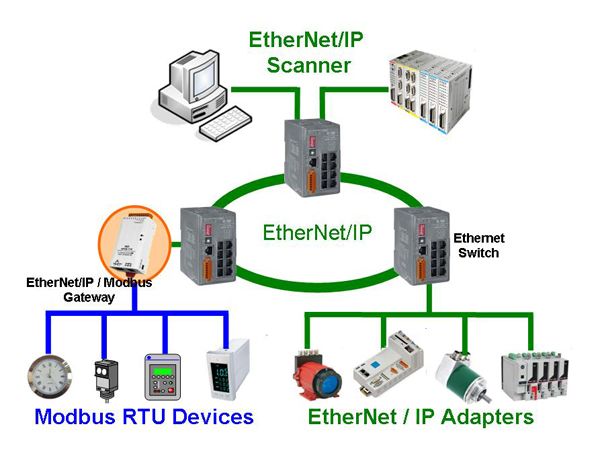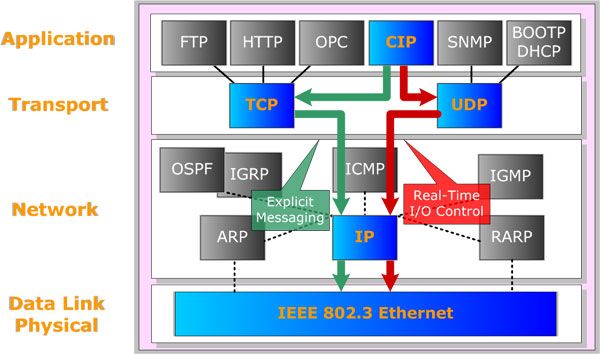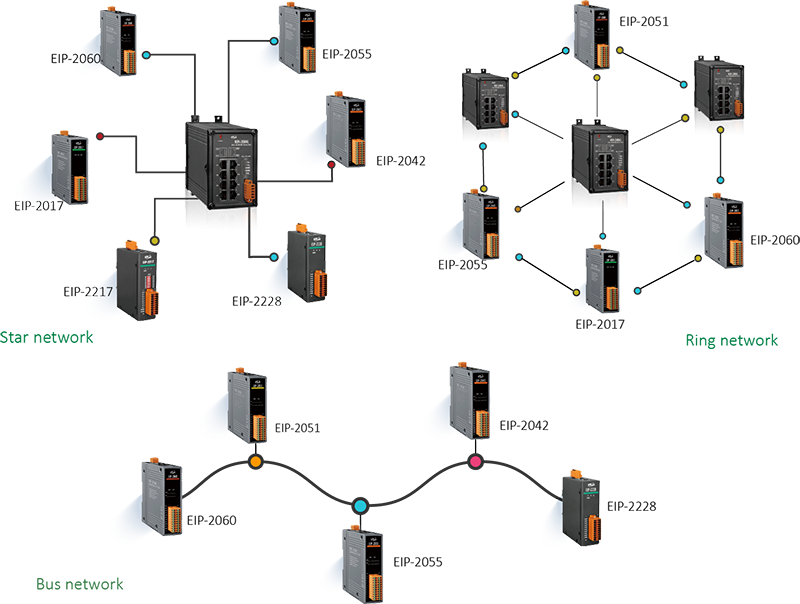EtherNet/IP is the name given to the Common Industrial Protocol (CIP), as implemented over standard Ethernet (IEEE 802.3 and the TCP/IP protocol suite).
EtherNet/IP was introduced in 2001 and today is the most developed, proven and complete industrial Ethernet network solution available for manufacturing automation, with rapid growth as users seek to harness the advantages of open technologies and the internet. EtherNet/IP is a member of a family of networks that implements CIP at its upper layers.

EtherNet/IP is one of the open network standards, like DeviceNet and ControlNet. It is an industrial application layer protocol for industrial automation applications. Ethernet/IP uses all of the protocols of traditional Ethernet including the Transport Control Protocol (TCP), the Internet Protocol (IP) and the media access and signaling technologies. Building on standard Ethernet technologies means that Ethernet/IP will work transparently with all the standard Ethernet devices found today. EtherNet/IP application layer is based on the “Common Industrial Protocol” (CIP) which is used in both DeviceNet and ControlNet. This standard organizes networked devices as a collection of objects. It defines the access, behavior and extensions, which allow vastly different devices to be accessed using a common protocol. Building on these protocols, Ethernet/IP provides a seam-less integrated system from the Industrial floor to the enterprise network.

Ethernet/IP uses all the transport and control protocols of standard Ethernet including the Transport Control Protocol (TCP), the User Datagram Protocol (UDP), the Internet Protocol (IP) and the media access and signaling technologies found in off-the-shelf Ethernet technology. Building on these standard communication technologies means that Ethernet/IP works transparently with all the standard Ethernet devices found in today's market-place.
Applications
- Automatic transfer lines, paint shops, and assembly lines
- Food processing/packaging
- Sectional conveyors
- Discrete-part machines
- Applications requiring fast response times
- Most of the high-speed applications that require high throughput and speed, high I/O count, distribution across large geographic distances, and real-time performance

Features
- Offer Producer-Consumer service that enable users to control, configure and collect data.
- Uses exiting IEEE standards for Ethernet physical layer and data link layer
- Provide flexible installation options leveraging commercially available industrial infrastructure products, including copper, fiber, fiber ring and wireless solutions.
- Provide robust physical layer options for industrial environments and includes the use of sealed RJ-45 and M12-4 D-coding connector.
- Compatible with general communication standards, including OPC, TCP/IP, HTTP, FTP, SNMP, DHCP.
- Use TCP port number 44818 for explicit messaging and UDP port number 2222 for implicit messaging
- Transfer of basic I/O data via UDP-based implicit messaging
- Uploading and downloading of parameters, programs and recipes via TCP
- Polled, cyclic and change-of-state monitoring via UDP
- *One-to-one (unicast), one-to-many (multicast), and one-to-all (broadcast) communication via TCP

Topology

|
|
||||
| Model | Digital Input & Output Module | |||
|---|---|---|---|---|
| Module Name | EIP-2042
|
EIP-2051
|
EIP-2055
|
EIP-2060
|
| Digital Input | ||||
| Channels | - | 16 | 8 | 6 |
| Contact | Dry + Wet | |||
| Sink/Source (NPN/PNP) | Sink/Source | |||
| Wet Contact On Voltage Level | +10 ~ 50 VDC | |||
| Wet Contact Off Voltage Level | +4 VDC Max. | |||
| Dry Contact On Voltage Level | Close to GND | |||
| Dry Contact Off Voltage Level | Open | |||
| Input Impedance | 10 kΩ, 0.5W | |||
| Digital Output | ||||
| Channels | 16 | - | 8 | 6 |
| Type | Open Collector | Open Collector | Power Relay | |
| Sink/Source (NPN/PNP) | Sink (NPN) | Sink (NPN) | Form A | |
| Load Voltage | +3.5 ~ +50 VDC | +3.5 ~ +50 VDC | 30 VDC/125 VAC | |
| Max. Load Current | 700 mA/Channel | 700 mA/Channel | 5 A @ 30 VDC 5 A @ 125 VAC |
|
| Overvoltage Protection | 60 VDC | 60 VDC | - | |
| Overload Protection | Yes | Yes | - | |
| Power-on Value | Yes | Yes | Yes | |
| Safe Value | Yes | Yes | Yes | |
|
|
||||
| Model | Analog Input Module | |||
|---|---|---|---|---|
| Module Name | EIP-2017
|
EIP-2217
|
EIP-2019/S
|
|
| Channels | Differential | 8 | ||
| Single-Ended | 16 | - | ||
| Sensor Type | - | Thermocouple (B,C,E,J,K,N,R,S,T) | ||
| Voltage Input Range | ±150 mV, ±500 mV, ±1 V, ±5 V, ±10 V | ±150 mV, ±500 mV, ±1 V, ±2.5 V, ±5 V, ±10 V | ±15 mV, ±50 mV, ±100 mV, ±150 mV, ±500 mV, ±1 V, ±2.5 V, ±5 V, ±10 V |
|
| Current Input Range | ±20 mA, 0 ~ +20 mA, +4 mA ~ +20 mA (Jumper Selectable) |
±20 mA, 0 ~ +20 mA, +4 ~ +20 mA (DIP switch selectable) |
±20 mA, 0 ~ +20 mA, +4 mA ~ +20 mA (Jumper Selectable) |
|
| Resolution | 16-bit | Normal Mode: 16-bit Fast Mode: 12-bit |
16-bit | |
| Sampling Rate | 10Hz | Normal Mode: 20 Hz (total channels) Fast Mode: 200 Hz (total channels) |
10Hz | |
| Accuracy | ±0.1% of FSR | Normal Mode: ±0.1% of FSR Fast Mode: ±0.5% of FSR |
±0.1% of FSR | |
|
|
||
| Model | Analog Output Module | |
|---|---|---|
| Module Name | EIP-2228
|
|
| Channels | 8 | |
| Type | Voltage | 0 ~ +5 VDC, ±5 VDC, 0 ~ +10 VDC, ±10 VDC |
| Current | 0 ~ 20 mA, 4 ~ 20 mA | |
| Resolution | 12-bit | |
| Accuracy | ±0.1% of FSR | |
| Short Circuit Protection | Yes | |
| DA Output Response Time | 1 ms per channel | |
| Programmable Output Slope | Voltage | 0.0625 ~ 512 V/Second |
| Current | 0.125 ~ 1024 mA/Second | |
| Open Wire Detection | For 4 ~ 20 mA only | |
| Voltage Output Capability | 10 V @ 10 mA | |
| Current Load Resistance | 500 Ω | |
| Individual Channel Configuration | Yes | |
| Power-on Value | Programmable | |
| Safe Value | Programmable | |


